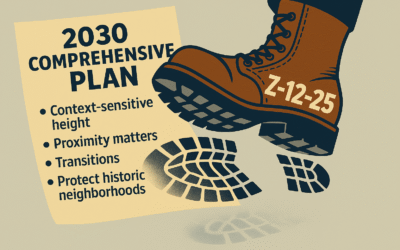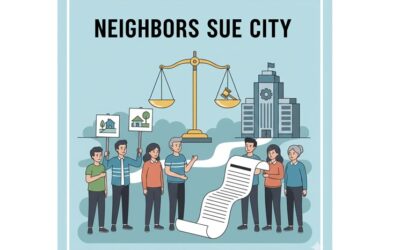The Glenwood-Brooklyn Legal Fund has been established and opened a GoFundMe account to support professional and legal efforts related to land-use, zoning, and community-impact issues affecting the Glenwood-Brooklyn neighborhood.
This Fund operates independently from the plaintiffs and from legal counsel. Please donate what you can now.
Z-12-25 and the Decision-Making Process
At the October 7, 2025 public hearing at 7 PM there were a few comments made during the hearing on rezoning request Z-12-2025 to which I would like to respond, in addition to general comments on the overall procedure of the public hearing process.
Glenwood-Brooklyn Group Notifies City of Lawsuit
The Glenwood-Brooklyn neighborhood group has hired The Brough Law Firm, PLLC to challenge this rezoning case. The firm is investigating what we believe are several defects in how the City has handled the situation. The City has laws and policies that are designed to create gentle transitions from slow, quiet neighborhoods to the busy downtown area. We believe that the City has ignored basic principles and is overrepresenting developer interests. There is no precedent for this rezoning at all. You can’t find a single high-rise this close to a historic district ACROSS THE ENTIRE STATE.
Don’t let Raleigh bulldoze our forests!
The rezoning case Z-11-25 (2230 S New Hope Rd) proposes development on a reforested, environmentally sensitive floodplain area. This forest is one of the last natural buffers remaining along New Hope Road, protecting nearby neighborhoods from flooding, erosion, and extreme heat. The Planning Commission has already recommended denial of this case, recognizing the significant environmental and community risks.
Don’t we want to increase our housing supply, not decrease it?
Every day of the year, tourists visit Oakwood to see our old houses that we work so hard to take care of. There are guided tours several times a week, and even tours by horse and carriage. We work very hard to be an amenity for the whole city. If you want a vibrant city, we are vibrant! This is only possible because we are a neighborhood, with people living in these old houses. Yet the Planning Department has been gradually rezoning our homes into office and commercial use. It’s no longer vibrant; it’s dead most of the time.
Raleigh’s Christmas Parade – Let the Children Participate!
I plead for your assistance in preserving one of Raleigh’s greatest cultural events—the Raleigh Christmas Parade. Christmas and Christmas Parades are for CHILDREN. I sat next to Hailey Brooks’ father in 2022 as he pleaded that you not eliminate the parade following his daughter’s tragic death. I am here to ask you to reconsider the banning of participation by the under-8 set unless they are on a vehicle. By doing so, you have effectively closed the opportunity to many children who don’t have a ride.
LET THE CHILDREN participate.
Council showed a complete lack of interest for residents’ concerns
It was hard to process the complete lack of interest or support by this City Council for the concerns repeatedly raised by residents. Countless emails, phone calls, meetings, and petitions were met with silence. Council was misled—partly by a Planning Department analysis that failed to identify any policy inconsistencies, and partly by Council member Silver’s one-sided defense that dismissed legitimate concerns raised by residents.
Mayor Cowell talked compromise for 6 months. What happened?
The approval of Z-12-25 was a huge disappointment to many of the residents in Raleigh’s neighborhoods. What is most disappointing is that there was a workable compromise that would have respected all parties.
City Council Disappoints Again with Z-12-25
The City Council’s decision to approve the rezoning case on West Street (Z-12-25), adjacent to the Glenwood-Brooklyn neighborhood, is hard to understand – unless, that is, you understand that a majority of Council always approves rezoning cases, no matter how outsized, because the development industry controls them.
Been There, Done That!
The city has grown enormously in the past few years, as people from all over began to recognize it’s a great place to live. But this growth was accompanied by absolutely no planning – or bad planning – which means we are now living in a helter-skelter atmosphere akin to a Third World city in which anything goes. Along with this has come a lapdog attitude when it comes to the city council’s relationship with developers. Sound familiar? This commentary was written 5 years ago in 2019.










